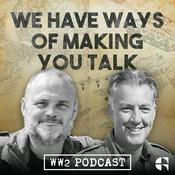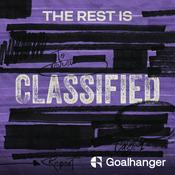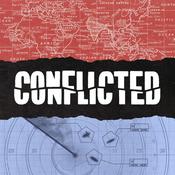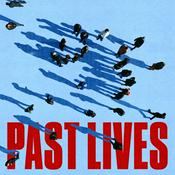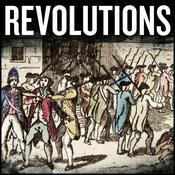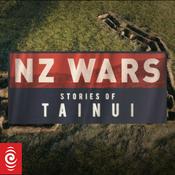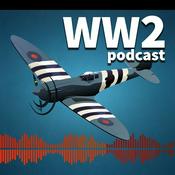521 episodes

Corporal Nils Mockler, USMC, World War II, Iwo Jima
24/12/2025 | 35 mins.
Nils Mockler joined the U.S. Marine Corps at the age of 17, only because they wouldn't let him join when he was 16. Upon enlisting in 1944, Mockler completed boot camp and was soon tapped as a combat intelligence scout. He also dabbled in explosives as you'll hear. After more training in Hawaii, Mockler and many other Marines left for Iwo Jima, where they would land in February 1945 and become part of one of the most vicious battles in the entire war.In this edition of Veterans Chronicles, Mockler takes us on board his ship as the battle plans were opened up and military planners thought Iwo Jima wold be a two-day mission. He also shares his experience coming ashore on D+1 and the fierce Japanese resistance he and the other Marines faces. Mockler also describes the battle-hardened unit he was attached to, the apprehension of sitting in his foxhole through the night in anticipation of Japanese attacks, and watching the cemetery of American service members grow far beyond what the battle planners could have imagined. And he describes the exhiliration of watching the American flag raised atop Mount Suribachi.

Sami Steigmann, Holocaust Survivor
17/12/2025 | 35 mins.
Sami Steigmann was born in Romanian controlled territory in December 1939. Before he turned two years old, he was a prisoner at the Mogilev-Podolski concentration camp. He was five when the war ended, but the impact of the Holocaust on his family and his own life carry on to this day. In this edition of Veterans Chronicles, Steigmann, shares the horrible conditions of his father's childhood, how Romania started as a Soviet ally but then aligned with Nazi Germany, and what life was like under both.Steigmann then explains the brutal conditions at Mogilev-Podolski and the desperate effort to find food. He shares what his father gave up for bread and tells us about the mysterious stranger who saved his own life. He was also subjected to medical experiments by the Nazis.We'll also learn about the nightmares Steigmann suffered after the war, why Steigmann's family moved to Israel in 1961, and about his service in the Israeli Air Force before he came to the United States.Now a public speaker about the Holocaust, Steigmann shares why it is vital for all generations to understand what happened and how and why is happened.

Maj. Gen. Matt Smith, U.S. Army, Iraq, Afghanistan
10/12/2025 | 35 mins.
Matt Smith grew up on Long Island and joined Army ROTC at the University of Delaware in 1989. Four years later, he was commissioned as an officer. Smith was working in the private sector and serving in the Army National Guard when the 9/11 terrorist attacks were perpetrated by Al Qaeda in 2001. Over the next two decades, Smith would be leading soldiers into combat during the invasion of Iraq and on two deployments in Afghanistan.In this edition of Veterans Chronicles, Smith takes us through the rapid invasion in Iraq and how he first learned about improvised explosive devices. He also tells us about a bizarre and fascinating mission he and his men undertook in western Iraq.Six years later, Smith served as a battalion commander in Afghanistan and saw the most intense combat of his career. He explains how the mission they trained for suddenly changed when they arrived, how he adjusted to the enemy strategically, and how he kept morale up despite deaths and serious injuries.Finally, Smith tells us about the work he is doing now to prepare other veterans for a successful business career after they leave the military.

MSG Ed Miklavcic, U.S. Army Air Corps, World War II, Pearl Harbor, Iwo Jima
03/12/2025 | 35 mins.
Ed Miklavic was one of 12 children and he ended up joining the U.S. Army Air Corps in 1940 because he tagged along with his brother and a friend to the Army recruiter. But Ed was better qualified than both of them. This was before the U.S. entered World War II, and the Army didn't even have a current uniform to give Miklavcic. Nonetheless, he headed out west for training and was stationed at Pearl Harbor's Wheeler Field leading up to the Japanese attacks on December 7, 1941.In this edition of Veterans Chronicles, Miklavcic tells us what his duties were before the attacks, how the attacks unfolded for him on December 7, and what he saw at Wheeler Field once the attacks were over.Miklavcic also describes his service on Iwo Jima. He explains why he came ashore days later than expected, what he saw when he landed, and his assignment at the airfields. He shares what it was like trying to dig and build in the black ash sand of Iwo Jima and to deal with Japanese mortar attacks and nighttime raids. He also remembers the iconic flag raising atop Mount Suribachi.Finally, Miklavcic stresses the importance of remembering the service and sacrifice of all who have fought, bled, and died for our nation.

William Keim, U.S. Merchant Marine, World War II
26/11/2025 | 36 mins.
William Keim joined the U.S. Merchant Marine in 1943 at the age of 17. He was called to active duty when he turned 18 years old that same year. For the next two years, he served as an oilerman on Liberty Ships in both the Atlantic and the Pacific theaters, transporting critical supplies and evading constant enemy efforts to sink their ships.In this edition of Veterans Chronicles, Keim tells all about the Liberty Ships and his role in keeping the engines running smoothly. He details the constant threat of German U-Boats in the North Atlantic, what the American vessels did to avoid getting sunk, and the horror of witnessing other ships getting hit without being able to help the souls on board.He also explains what it was like for the ships to be strafed by German planes and also be the targets of buzz bombs while in port on Christmas 1944. Finally, Keim shares what it was like for the U.S. Merchant Marine veterans to receive the Congressional Gold Medal and long overdue recognition for their service.
More History podcasts
Trending History podcasts
About Veterans Chronicles
Listen to Veterans Chronicles, WW2 Pod: We Have Ways of Making You Talk and many other podcasts from around the world with the radio.net app

Get the free radio.net app
- Stations and podcasts to bookmark
- Stream via Wi-Fi or Bluetooth
- Supports Carplay & Android Auto
- Many other app features
Get the free radio.net app
- Stations and podcasts to bookmark
- Stream via Wi-Fi or Bluetooth
- Supports Carplay & Android Auto
- Many other app features


Veterans Chronicles
download the app,
start listening.
